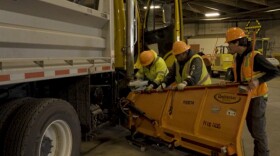-
The 25-year-old raced for the Pinedale High School Nordic Ski Team and got into biathlon while going to college in Alaska.
-
Services will be limited. But guided tours are available, and some areas are maintained for cross country skiing and snowshoe hikes.
-
The Wyoming Department of Transportation is responsible for roughly 350 snowplows across the state.
-
Teton Village runner Anna Gibson is aiming to secure a spot in the sport of ski mountaineering. Alta-grown skier Jaelin Kauf is already set to compete in the single and dual mogul events.
-
Federal funding has been restored to Wyoming’s home heating assistance program, albeit delayed. More than 3,900 applications have been pending since the program ran out of money on Oct. 15.
-
The zones are managed by the Wyoming Game and Fish Department and make up more than 500,000 acres of land, with access to more than 200 miles of streams.
-
La Niña conditions appeared in October, and these conditions are forecasted to stick around through the winter months. La Niña is a weather phenomenon that favors a more active jet stream across the northern half of the country, which can create more winter storms.
-
Some classic spots in Grand Teton National Park (GTNP) open up for cross-country skiing, snowshoeing and walking on Dec. 20. Explore Moose-Wilson Road, Signal Mountain Summit Road and Teton Park Road, which’ll be regularly groomed throughout the winter.
-
More precipitation is falling as rain, instead of snow — which impacts ski resorts, tourism and ecosystems.
-
Avalanche centers across our region were exempted from a U.S. Forest Service hiring pause for seasonal workers.
© 2025 Wyoming Public Media
800-729-5897 | 307-766-4240
Wyoming Public Media is a service of the University of Wyoming
800-729-5897 | 307-766-4240
Wyoming Public Media is a service of the University of Wyoming

Play Live Radio
Next Up:
0:00
0:00
Available On Air Stations











